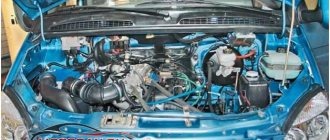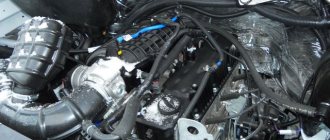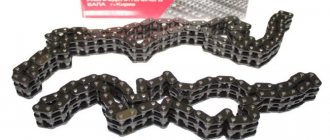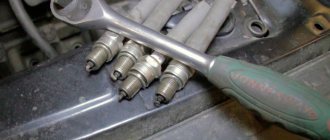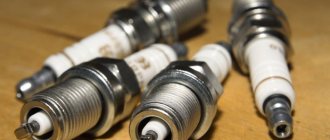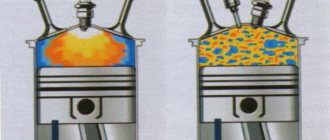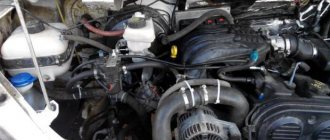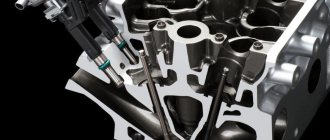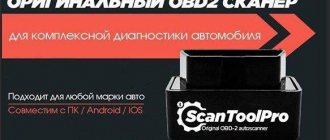Site about off-road vehicles, SUVs, off-road vehicles
The UMZ-4216 engine is intended for use in cars and trucks using a three-component catalytic converter in the exhaust system and ensures that the vehicle complies with Euro-3 toxicity standards corresponding to UNECE Rules No. 83-05.
UMZ-4216 engine, characteristics, data for adjustments and control, features of starting, stopping and running in the UMZ-4216 engine.
The UMZ-4216 engine contains a device for injecting gasoline into the intake channels (fuel pipe and injectors), a customized exhaust system, as well as sensors and actuators for working in an adaptive fuel supply and ignition control system with feedback via an oxygen sensor (in the exhaust system) and a sensor detonation (on the cylinder head).
The engine configuration 4216.1000400 is a gasoline engine with an integrated microprocessor control system for fuel injection and ignition; in the configuration 4216.1000400-20 there is an additional power steering pump.
Engine UMZ-4216, appearance on the left, front and right.
Technical characteristics of the UMZ-4216 engine.
Engine type - 4-stroke petrol with microprocessor controlled fuel supply and ignition. The number of cylinders is four. The order of operation of the cylinders is 1– 2 – 4 – 3. Cylinder diameter, mm – 100 Piston stroke, mm – 92 Displacement, l – 2.89 Compression ratio – 8.8
Rated power, kW (hp) at a crankshaft speed of 4000 rpm: gross - 90.4 (123) net - 78.7 (107) Maximum torque, Nm (kgcm) at a crankshaft speed of 2200- 2500 rpm: gross - 235.4 (24) net - 220.7 (22.5) Idle speed, rpm: minimum - 800+-50 maximum - 4500 Minimum specific fuel consumption according to external speed characteristic (gross configuration), no more, g/kWh (g/hp/h) — 269.3 (198) Oil consumption for waste as a % of fuel consumption (after vehicle mileage of 5000 km), not more - 0.2
The fuel supply system is distributed phased injection. The cooling system is liquid, closed, with forced circulation. Cooling system capacity without cooling radiator capacity, l - 3.5 Lubrication system - combined, under pressure and splash. Oil system capacity, without oil cooler capacity, l - 5.8
Electrical equipment is single-wire, the negative leads of the products are connected to the car body. The nominal voltage of the battery is 12 Volts. Generator - 9402.3701-17, 33.3771010, 4216.3708000-01 Starter - 422.3708000, 5732.3708000 Ignition system - microprocessor ignition control system with detonation feedback.
Clutch - single disc, dry. Weight of the engine unfilled with lubricant, kg - 172
Data for adjustments and monitoring the condition of the UMZ-4216 engine.
Gap between rocker arms and valves on a cold engine at 15-20 degrees, mm: - for exhaust valves of cylinders 1 and 4: 0.3-0.35 - for other valves: 0.35-0.4 Belt deflection when pressed with a force of 40N (4 kgf), mm: - between the fan and tension roller pulleys: 8-10 - between the generator and water pump pulleys: 7-9 - between the crankshaft pulleys and power steering pump: 12-17 Oil pressure (for control, no adjustment subject) at oil temperature plus 80 degrees, kPa (kgf/cm2): with the oil cooler turned off: - at 700 rpm: 125 (1.3)* - at 2000 rpm: 340 (3.5)* at oil cooler on: - at 700 rpm: 78 (0.8)* - at 2000 rpm: 245 (2.5)*
Minimum crankshaft rotation speed in idle mode, rpm: 800+-50 Gap between spark plug electrodes, mm: 0.7-0.8 Coolant temperature should be within the range, degrees: from plus 80 to plus 95 Installation ignition timing angle (in degrees of crankshaft rotation): 5 Oil consumption for waste, as a percentage of fuel consumption: 0.2*
* — Values of indicators for the warranty period of engine operation.
Features of starting and stopping the UMZ-4216 engine.
Before starting the UMZ-4216 engine with an unfilled power system, it is recommended to bleed air through a special fine fuel filter screw to speed up pumping of the fuel supply system. Starting and operating the UMZ-4216 engine. with the diagnostic warning light on, it can lead to failure of the converter and the oxygen concentration sensor. When starting the engine, do not press the throttle pedal.
After starting the engine, the engine control system will automatically set the required engine speed to warm up the engine and will gradually, as the engine warms up, reduce it to the minimum. If the UMZ-4216 engine does not start after 3 attempts, press the throttle pedal all the way and turn on the starter for 2-3 seconds. In this case, the control unit will perform the “Engine cylinder purge mode” function, and then try to start again. Before stopping the engine, it is necessary to let it run for 1-2 minutes at low crankshaft speed, then turn off the ignition.
Features of running in the UMZ-4216 engine.
Long-lasting and trouble-free operation of the UMZ-4216 engine largely depends on the running-in of parts during the initial period of operation. Observe the following instructions during the running-in period:
— The crankshaft rotation speed should be no more than 3000 rpm. — Avoid overloading the engine, do not allow high speeds and maximum vehicle load. — Monitor the coolant temperature. Avoid operating the engine at coolant temperatures close to the maximum limit.
Source
General diagram of electrical equipment Gazelle UMZ 4216 injector
General diagram of electrical equipment Gazelle UMZ 4216 injector
1. Diagram of the front of the car
1 Right headlight unit 2 Starter 3 Battery 4 Fuse block in the engine compartment 5 Generator 6 Left headlight unit 7 Windshield wiper 8 connection block to the windshield wiper wiring harness 9 engine compartment lamp 10, 16 horn 11 windshield washer 12, 14 connection blocks with the anti-lock brake system wiring harness 13 brake fluid level sensor 15 starter relay 17 heater valve 18 connection block with the heater valve wiring harness 19 additional heater pump 20, 21, 22 connection blocks with the engine management system wiring harness 23, 24 connection blocks with rear wiring harness 25, 26 connection block with instrument panel wiring harness 27 connection block (not used)
2. Diagram of the central part of the car
1, 2 connection blocks (not used) 3, 4 connection blocks with the front wiring harness 5 additional heater fan switch 6 right steering column switch 7 horn switch 8 spiral cable 9 turn relay 10 left steering column switch 11 connection block with the ignition switch wiring harness 12 ignition switch 13 connection block with the lower right speaker 14 connection block with the right steering column switch 15 connection block with the ground wiring harness 16 connection block with the lower left speaker 17 right outside rear view mirror 18 connection block with the wiring harness of the right front door 19 connection block with exterior rear view mirror wiring harness 20 connection block to the upper interior wiring harness 21, 22 connection blocks to the upper speakers 23 Footrest lamp 24 connection block to the lower interior wiring harness 25 additional heater fan 26 additional resistor (0.85 Ohm, 35 W) 27 reverse light switch 28 speed sensor 29 parking brake warning switch 30 connection block to the left door wiring harness 31 connection block to the exterior rear view mirror wiring harness 32 left exterior rear view mirror 33 right interior light 34 front interior light 35, 36 left interior lamps 37 interior fuse and relay mounting block 38 heated mirror relay 39 low beam relay 40 high beam relay 41 horn relay 42 heater pump relay 43 windshield wiper relay 45 fuses 46 lighting control unit 47 heating and ventilation system control unit 48 instrument cluster 49 micromoto-reducer (MMR) for driving the windshield blower flaps and footwells 50 MMR for driving the instrument panel deflector flaps 51 MMR for driving the central damper 52 MMR for driving the recirculation flaps 53 socket 54 cigarette lighter 55 heater fan 56 electronic speed controller for heater fan 57 dome light glove box 58 glove compartment lamp switch 59 interior lighting switch 60 brake pedal position sensor and brake signal switch 61, 62 connection blocks to the head audio unit 63 connection block (not used) 64 connection block to the extension cord 65 connection block to the heater fan
3. Electronic engine control system diagram
1 Canister purge valve 2 Throttle position sensor 3 Coolant temperature sensor 4 Fan clutch 5 Idle speed control 6 Terminal D gerator 7 Emergency oil pressure warning sensor 8 Ignition coil 9 Spark plugs 10 Absolute pressure and intake air temperature sensor 11 Phase sensor 12 Crankshaft position sensor 13 Connection block to the wiring harness of the control oxygen concentration sensor 14 Control oxygen concentration sensor 15 Rough road sensor 16 Knock sensor 17 Connection block to the injector wiring harness 18 Injectors 19 Fan clutch relay 20 Main relay 21 Fuel pump relay 23, 24 Blocks connections with the front wiring harness 25 Connection block with the wiring harness of the diagnostic oxygen concentration sensor 26 Diagnostic oxygen concentration sensor 27 electronic engine control unit (controller) MIKAS M10.3 Connection diagram of the front wiring harness GAZelle-Business
4. ABS connection diagram
1 connection block with the front wiring harness 2 diagnostic block for the ABS system 3 connection block with the ABS power supply harness 4 right front wheel speed sensor 5 right rear wheel speed sensor 6 left front wheel speed sensor 7 left rear wheel speed sensor 8 electronic ABS control unit
Design
This is one of the varieties of the UMZ-421 power plant. The “four hundred and twenty-first” line also includes motors 4213, 4215, 4218.
UMZ-4216 stands out among them as follows:
In the UMZ-4216 engine model with a 92 mm caliber piston, the liners in the cylinder block are of the “wet” type, they can be removed. But in a more powerful modification with a piston diameter of 100 mm, the sleeve is firmly pressed into the corresponding compartment using a powerful press and cannot be removed.
Service
UMZ-4216 is a simple and unpretentious engine designed for commercial vehicles. Engine maintenance must be carried out regularly, in accordance with the maintenance schedule.
Maintenance work is divided into 3 groups:
Every day in the UMZ-4216 engine it is necessary to check the oil level, coolant, tightness of the cooling system, lubrication system and fuel supply lines. With in-depth control, which is carried out according to a schedule, the following is added to these works:
According to the approved regulations, the following manipulations are performed on the UMZ-42616 engine every six months:
Determination of early or late ignition
The stability of the engine, its power, fuel efficiency, etc. directly depend on the correct settings and uninterrupted operation of the ignition system. Normally, on four-stroke engines, the fuel-air mixture should ignite at the end of the compression stroke, that is, just before the piston rises to top dead center. This ignition timing is due to the fact that the mixture requires a certain time to burn, after which the energy of the expanding gases pushes the piston down and the power stroke begins.
Late or early ignition should be understood as a delay or advance in the operation of the ignition system in relation to the position of the piston in the cylinder. In other words, a spark plug spark forms and ignites the fuel-air mixture not at the optimal moment when the piston approaches TDC, but earlier or later than this moment. This phenomenon is called early or late ignition. For this reason, owners of vehicles that have the ability to independently adjust the ignition timing (ignition timing) are often faced with the need to adjust the ignition.
Engine device
UMZ-4216 is a gasoline injection engine with electronically controlled ignition and injection. Number of cylinders – 4, engine displacement 4216–2.89 liters. The unit in the basic version is capable of producing power up to 107 horsepower.
The basis for the development was the ZMZ-21 engine. The new UMP model has a similar design:
The oil sump, stamped from steel, is also structurally similar.
Crankcase of Gazelle Business 4216 engines and related modifications:
As in all UMZ engines with 100 mm cylinders. in diameter, the sleeves are pressed into the BC and cannot be pressed out during repairs. If the cylinders wear out, the entire block will have to be replaced.
Main elements of the 4216 engine:
Engine removed:
The crankshaft drives the timing belt through gears. Rods and pushrods transmit the movement coming from the camshaft to rocker arms, which operate the intake and exhaust valves.
Engine control is electronic. The engine operation is controlled by the MIKAS electronic unit, which receives signals from the TPS, shaft position sensor, knock and pressure sensors.
Sensor diagram from the official manual:
Conclusion
Determining why the “Check Engine” blinks on a Gazelle Business with a UMZ 4216 engine and tripping appears is quite simple. To do this, it is worth carrying out a comprehensive diagnosis of the electronic control unit and deciphering the error codes. If this does not give anything, then the problem should be looked for in the formation of the air-fuel mixture or the ignition system.
During the operation of a GAZelle Business and Sable Business vehicle, the MIKAS 12.3 ECU of the UMZ-42164 Euro-4 engine monitors the serviceability of the engine control systems based on indirect signs. A prerequisite for such monitoring is the serviceability of the sensors involved in the corresponding control circuit.
Diagnostics of the power supply, ignition and exhaust system of the UMZ-42164 Euro-4 engine with MIKAS 12.3 ECU on GAZelle Business and Sable Business cars.
When diagnosing the fuel system of a GAZelle Business and Sable Business car, the MIKAS 12.3 ECU can set the mixture to be excessively rich or lean based on the value of the average fuel correction coefficient. Error codes P0171 (too lean) or P0172 (too rich) can be set if the average fuel trim ratio is above 1.30 or below 0.70 for 100 seconds.
While the UMZ-42164 Euro-4 engine is running, this check is performed continuously. Provided that the system operates with closed feedback via a lambda probe with an active correction algorithm and a lambda probe switching period of more than 0.1 Hz. A prerequisite for the test is the absence of errors in the oxygen sensors, pressure, throttle position and oxygen sensor heater.
Technical characteristics of UMZ 4216
As already mentioned, the UMZ 4216 engine is a four-cylinder injection gasoline unit with 8 valves. The manufacturer declares 92 gasoline as the main fuel, but the use of gasoline with an octane number of 95 (as an additional one) is also permitted.
Technical characteristics of the UMZ 4216 engine:
| Name of motor characteristics | Meaning |
| Unit volume (working) | 2.89 liters. |
| Maximum engine power | 107 forces (can be up to 123, depending on the model) |
| Torque (max) | 235 N*m at 2200-2500 rpm. |
| Cylinders per engine | 4 |
| The order of activation of the cylinders in the working cycle | 1-2-4-3 |
| Fuel | Gasoline, unleaded Regular-92 (basic, optional 95, Premium and Euro) |
| Consumption per hundred | Nominally 11 liters in city mode, about 10 on the highway (actual numbers may vary) |
| Supplying the mixture to the cylinders | Injector |
| Feed control | Electronic |
| Engine cooling system | Closed type, liquid, refrigerant circulation - forced |
| Weight including clutch and electrical equipment | 172 kilograms |
Gasoline consumption declared by the manufacturer is not an absolute value and can increase significantly depending on the season of operation of the vehicle, load, and driving style. For example, the average fuel consumption of the GAZelle Business engine UMZ 4216 in reality shows about 13-15 liters in the city.
Engine assembly. Part 3
Install the oil pump so that the drive shank fits into the groove of the shaft and secure it with bolts and washers (Key S=12). Secure the discharge tube to the block with nuts and washers (Key S=13). Check the ease of rotation of the oil pump shaft.
- Take the oil sump and insert the front and rear gaskets into the sockets of the oil sump so that their ends protrude beyond the plane of the connector by the same amount
- Place two oil sump gaskets on the oil sump mounting studs and lubricate the ends of the gaskets with Avtogermesil sealant glue.
- Install the oil sump assembly with gaskets onto the oil sump mounting studs and secure with nuts and washers (Key S=13)
- Place the gasket on the plane of the clutch housing and install the clutch housing (lower part) and screw it with bolts and washers (Key S=12) Turn the engine 180°
- Adjust the valves of the car engine: set the piston of the first cylinder to TDC of the compression stroke, while the mark on the crankshaft damper should align with the installation mark on the camshaft cover.
- Set the gap with a feeler gauge to 0.35 mm between the rocker arms and the 1, 2, 4, 6 valves and tighten the lock nuts of the adjusting screws.
- Rotate the crankshaft 360°, align the marks, i.e. Set the piston of the fourth cylinder to the TDC position on the compression stroke.
- Adjust the gaps between the 3,5,7,8 valves and rocker arms with a 0.35 mm feeler gauge and tighten the locknuts of the adjusting screws.
The engine is assembled and ready for hot running on the test bench.
source
Problems with ignition and fuel supply systems
These problems are considered typical for engines with the 4216 series injector.
The reason is failures in the ECU or diagnostic ones.
Possible reasons are failure of the computer, control circuits or the control system as a whole.
The probable cause is pump failure, problems with the computer, power circuits or pump relay.
It is possible that the battery is discharged, the throttle or the starter itself is faulty, or there is a breakdown in the control/supply circuits of the starter.
The reason is a malfunction of the synchronization sensor or an increase in the gap between the synchronization sensor and the teeth of the crankshaft synchronization disk.
Possible malfunctions - there is no fuel pressure in the line, the pressure is too low or, conversely, high, the IAC, crankshaft sensor, control unit has failed, or the coil control circuits have been mixed up during installation.
It is necessary to carefully check all these nodes. Thus, fuel pressure may drop due to the trivial reason of an empty tank or an air lock in the line. Low pressure occurs when the fuel channels and filter are clogged, suction appears in the intake tract, a faulty gasoline pressure regulator or leaky gasoline lines. Too high pressure may occur due to a broken pressure regulator, a clogged drain line, or a broken fuel pump.
Reasons: the throttle valve does not close completely, the coolant temperature sensor is miscalibrated, the IAC channel does not close.
Reasons: malfunction of the armor wire or tip, violation of the spark plug gap, carbon deposits on it, or complete breakdown of the spark plug, problems with power supply/control of the injector, clogging or breakdown of the latter. Occasionally, a malfunction occurs due to ECU failures.
Possible reasons: malfunction of the ignition coils (or their power supply and control systems), computer failure.
Possible malfunctions leading to this: suction at the inlet, in the engine crankcase ventilation or brake system, water getting into the tank, rattling of the TPS contacts.
The error occurs due to problems with ignition or chattering of the TPS contacts.
Reasons: the throttle valve does not open completely, the fuel filter is clogged, the TPS is miscalibrated, the air filter is dirty, the absolute pressure sensor is broken, or the high-voltage circuits of the engine are faulty.
Problems leading to this: failure of the absolute pressure sensor, depressurization of injectors, air leaks, too high pressure in the fuel line (see above).
As a rule, this occurs due to faulty high-voltage circuits.
Possibly, low-quality gasoline was poured in (with an incorrect ratio of fractions, low octane number, or diluted with water). The problem may also lie in broken shielding of the knock sensor cables, sensor calibration, or ECU failure.
Owner reviews
Those who drive personal and business cars with a UMZ 4216 engine generally praise these engines. The main advantages, according to car enthusiasts:
Many experienced car owners even do their own repairs; in general, service operations are quite simple and can be carried out almost in the field. Only the injector can cause complexity - its design, repair and adjustment are fundamentally more complicated when compared with carburetor analogues, and require special knowledge and equipment.
But there are also negative reviews. Main complaints:
Most of the complaints are related to the fact that the driver came across a copy of the engine with a defect, which, although not so often, does happen. Typical factory defects of the 4216 series engine:
There are often cases when owners, faced with problems, modify the engine themselves. For example, to combat overheating, a three-row copper radiator is installed, which replaces the standard cooling element: copper copes with its tasks better. Another popular method is to equip the engine with an electric fan, the control switch of which is brought into the cabin. If the coolant sensor shows a critical temperature, the person driving activates additional forced cooling.
Motorists note that a complete engine overhaul eliminates the bulk of “generic diseases”, provided that the work is carried out competently and using high-quality original parts.
Alternatives
If the driver “came across” a car with a defective engine, which he has no desire to constantly repair, he can try to replace it with another one suitable for the car. There are different options for swapping an engine, but mostly those who decide to swap choose the ZMZ-405 engine. This choice is due to several reasons:
The GAZelle-Business plant now regularly installs a Cummins turbodiesel power unit, but the option of replacing it with it is rarely considered due to the high cost and high sensitivity of the American engine to fuel quality, with which there are traditional problems in Russia.
Source
Eventually
From the factory, the UMZ4216 gasoline engine of the GAZelle Business vehicle is equipped with Brisk LR15YC spark plugs. They should be replaced by the same ones, since they are unpretentious for 30,000-40,000 km. Analogues from BOSCH, NGK, BERU, DENSO performed no worse. A good option is the domestic A17DVRM.
Replacing ignition elements is quite primitive. Disconnect the ground, remove the wire, clean the space around the spark plug and unscrew it with a 21 spark plug wrench. Afterwards, a new part is screwed in.
